|
Coopers of Stortford is not an unfamiliar name to this area, but the firm's take-over of this store – previously Maslens – on 8 March 2004 came as a bit of a surprise to local inhabitants.
The names Maslens and Bishop's Stortford had been synonymous since the mid 1980s, but the store's business origins stemmed back to the early 1900s when the premises was under the joint ownership of Mr F Handscomb – seller of agricultural hand tools – and Mr F. Chaplin – seller of horse collars.
In 1944 it was suggested the property be bought by the council and then demolished to become a car park, and in the late 1940s it became a hardware store trading under the sole name of Handscomb’s. Various allied businesses were later developed, but in the mid 1980s all of Handscomb's interests were brought together under one umbrella and renamed Maslens Sales Ltd.
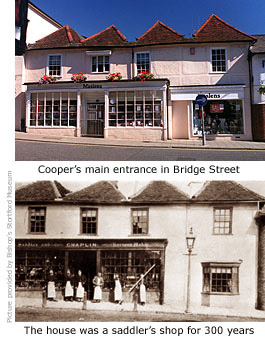 The store occupies three separate inter-linked buildings, the smallest of which at the corner of Water Lane housed a cafe in the 1950s. But the main departments are to be found in two much older buildings, each of slightly more historical interest. The store occupies three separate inter-linked buildings, the smallest of which at the corner of Water Lane housed a cafe in the 1950s. But the main departments are to be found in two much older buildings, each of slightly more historical interest.
The first of these, adjacent to Old River Lane, is a 19th century malthouse originally built and owned by former local maltsers, Flinn & Sons. When their tenure ended in the early 1900s the building remained largely derelict, but after the Second World War it was used as a warehouse for storing army surplus webbing. Handscomb's bought it in the late 1950s for use as a builders' merchant. The timber-clad exterior is extremely well preserved, as are its three large kiln chimneys and the sack hoist above the store’s Bridge Street entrance, once used for unloading barley grain from carts parked below.
The store's main entrance in Bridge Street opens into a large, 16th century timber-frame building with hipped roof – the roof being rebuilt in the early 18th century and possibly replacing vertical gables. First constructed as a private house and standing in its own grounds, the store now gives little clue to its former state before refurbishment in the early 1960s. At that time the dark interior was still a maze of rooms and passages with sloping floors and different ceiling heights, and though most of the early 17th century wood panelling was removed, some is still in evidence in first floor offices.
The first owner of the house was Nicholas Parsons, a nephew of Bishop Edmund Bonner the notorious persecutor of Protestants under the catholic rule of Queen Mary (1553–1558). Bonner replaced the protestant bishop of London, Nicholas Ridley, who Mary later had burnt at the stake for his religious beliefs. Locally, Bonner exerted his own powers in 1554 by forcibly removing from St Michael’s church a young protestant priest by the name of Richard Fletcher, simply because he was married. Ironically, in 1595 his son from the marriage, also Richard Fletcher, became bishop of London under the rule of Elizabeth I (See Guide 4).
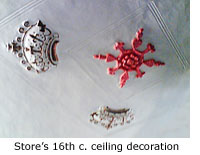 Bishop Bonner occasionally stayed in this house when visiting Stortford and sometimes held court here – judging those accused of heresy and destined for imprisonment in the gaol at nearby Waytemore Castle. It's because of his association with the premises that it has been referred to as the ‘Bishop’s Palace’, but his palace was in fact at nearby Great Hadham – now called Much Hadham – and still exists. Bishop Bonner occasionally stayed in this house when visiting Stortford and sometimes held court here – judging those accused of heresy and destined for imprisonment in the gaol at nearby Waytemore Castle. It's because of his association with the premises that it has been referred to as the ‘Bishop’s Palace’, but his palace was in fact at nearby Great Hadham – now called Much Hadham – and still exists.
There is, however, little doubt that the house once accommodated lesser members of the clergy who, to honour and please the bishop, would decorate its walls and ceilings with paintings and ornate works. A perfect example of this still survives just inside the shop’s main entrance where plaster decoration on the ceiling, known as pargetting, has been carried out by an experienced craftsman of that period. It's likely that clergy ceased to be associated with the house soon after Queen Mary's death, because for over three hundred years it was a saddler's shop.
Between Cooper's two entrances in Bridge Street stands a small 19th century building that houses shops with offices above. In the mid 1800s the part of this building adjacent to Cooper's store (currently occupied by Photosound) was used as a stable and wine store, and in 1876 became the town post office run by Bishop’s Stortford’s first Postmistress, Mrs Elizabeth Millard.
At the turn of the 20th century the premises became Tucker & Spearman’s cycle shop, the young Misses Spearman apparently causing a local sensation by being the first young ladies in the town to wear ‘cycling bloomers’.
No reference can be found of Mr Tucker, or of when the partnership was formed, but it is recorded that Egbert Spearman arrived in Stortford around 1890, possibly from Braintree in Essex. An enthusiastic sportsman he once played for Gordon Football Club at Braintree and did a considerable amount of cycle racing in the district. Undoubtedly it was the latter that spurred him to found his own cycle shop in South Street shortly after arrival here.
The partners' shop continued to flourish after the move to Bridge Street, but when Egbert Spearman's wife died in the early 1920s he gave up his share of the business. His home in Warwick Road was named 'Gordon', presumably a reference to the football club he had once played for, and was where he died on 1 June 1945, aged 73 years.
|
|
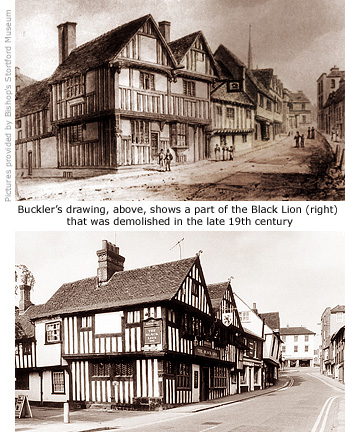 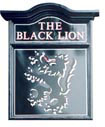 In 1996 this fine 16th century inn, known for almost 400 years as the Black Lion, had its name changed to Scruffy Macs. A totally meaningless title it was yet another example of modern-day trends to attract a younger patronage. Thankfully, the name was short-lived and in 2003 the pub's traditional title was reinstated. In 1996 this fine 16th century inn, known for almost 400 years as the Black Lion, had its name changed to Scruffy Macs. A totally meaningless title it was yet another example of modern-day trends to attract a younger patronage. Thankfully, the name was short-lived and in 2003 the pub's traditional title was reinstated.
The name Black Lion originates from the emblem of Edward III’s wife, Queen Philippa (1327–1369), the daughter of the Count of Hainault (a province in Belgium) who, by arrangement, married the fifteen-year-old king in 1328. Her only other tenuous link with Bishop’s Stortford was when Edward granted Ralph de Stratford, bishop of London, permission to found a chantry of secular priests in the chapel of St Paul’s within Waytemore Castle. The priests were to live in the castle and in return pray for the souls of Philippa and the bishop.
Ironically, the word ‘Black’ figured prominently in the Queen’s life: her eldest son, Edward, Prince of Wales, gained notoriety as the Black Prince and in 1348 her daughter, Joan, died as a result of the bubonic plague – also known as the Black Death. Philippa herself fell victim to a later outbreak of the Black Death in 1369.
Like the house opposite (now part of Cooper's store) this building was also allegedly used by bishop Bonner to hold prisoners accused of heresy, and tradition has it that a bridge once linked the two buildings over which felons would cross to the bishop’s Court House for their hearing. It was this bridge that is supposed to have given Bridge Street its name but it’s highly unlikely such a structure ever existed.
In the early 19th century the inn was leased to the town brewers Hawkes and Co, (See Guide 6), who bought it outright in 1849. Like most buildings of the Tudor period the inn’s exterior was originally plastered over to hide its timber-frame structure but when, in 1899, the property was renovated by local builder Joseph Glasscock, he painstakingly removed every inch of the plaster to reveal what we see today.
Incorporated in the inn’s structure is a jettied building of two storeys that stands in Devoils Lane. This formerly housed extensive stables that, in bishop Bonner’s day, are thought to have also been used as a stable block by the house opposite (now Cooper's). To the right of the inn, in Bridge Street, a very small part of another jetty is all that remains after it was demolished in the late 19th century and replaced by the small brick-built building that now adjoins it. Sadly, the ground floor of the pub interior retains very little original work, although 16th century construction features are still apparent on the first floor. MORE PICTURES
|

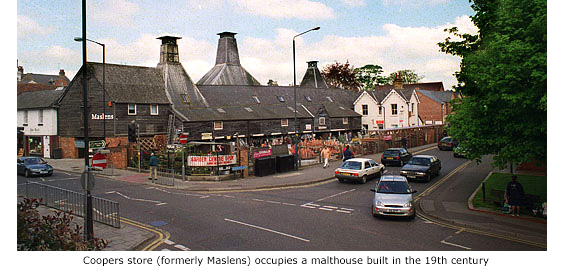


 The store occupies three separate inter-linked buildings, the smallest of which at the corner of Water Lane housed a cafe in the 1950s. But the main departments are to be found in two much older buildings, each of slightly more historical interest.
The store occupies three separate inter-linked buildings, the smallest of which at the corner of Water Lane housed a cafe in the 1950s. But the main departments are to be found in two much older buildings, each of slightly more historical interest. Bishop Bonner occasionally stayed in this house when visiting Stortford and sometimes held court here – judging those accused of heresy and destined for imprisonment in the gaol at nearby Waytemore Castle. It's because of his association with the premises that it has been referred to as the ‘Bishop’s Palace’, but his palace was in fact at nearby Great Hadham – now called Much Hadham – and still exists.
Bishop Bonner occasionally stayed in this house when visiting Stortford and sometimes held court here – judging those accused of heresy and destined for imprisonment in the gaol at nearby Waytemore Castle. It's because of his association with the premises that it has been referred to as the ‘Bishop’s Palace’, but his palace was in fact at nearby Great Hadham – now called Much Hadham – and still exists.
 In 1996 this fine 16th century inn, known for almost 400 years as the Black Lion, had its name changed to Scruffy Macs. A totally meaningless title it was yet another example of modern-day trends to attract a younger patronage. Thankfully, the name was short-lived and in 2003 the pub's traditional title was reinstated.
In 1996 this fine 16th century inn, known for almost 400 years as the Black Lion, had its name changed to Scruffy Macs. A totally meaningless title it was yet another example of modern-day trends to attract a younger patronage. Thankfully, the name was short-lived and in 2003 the pub's traditional title was reinstated.